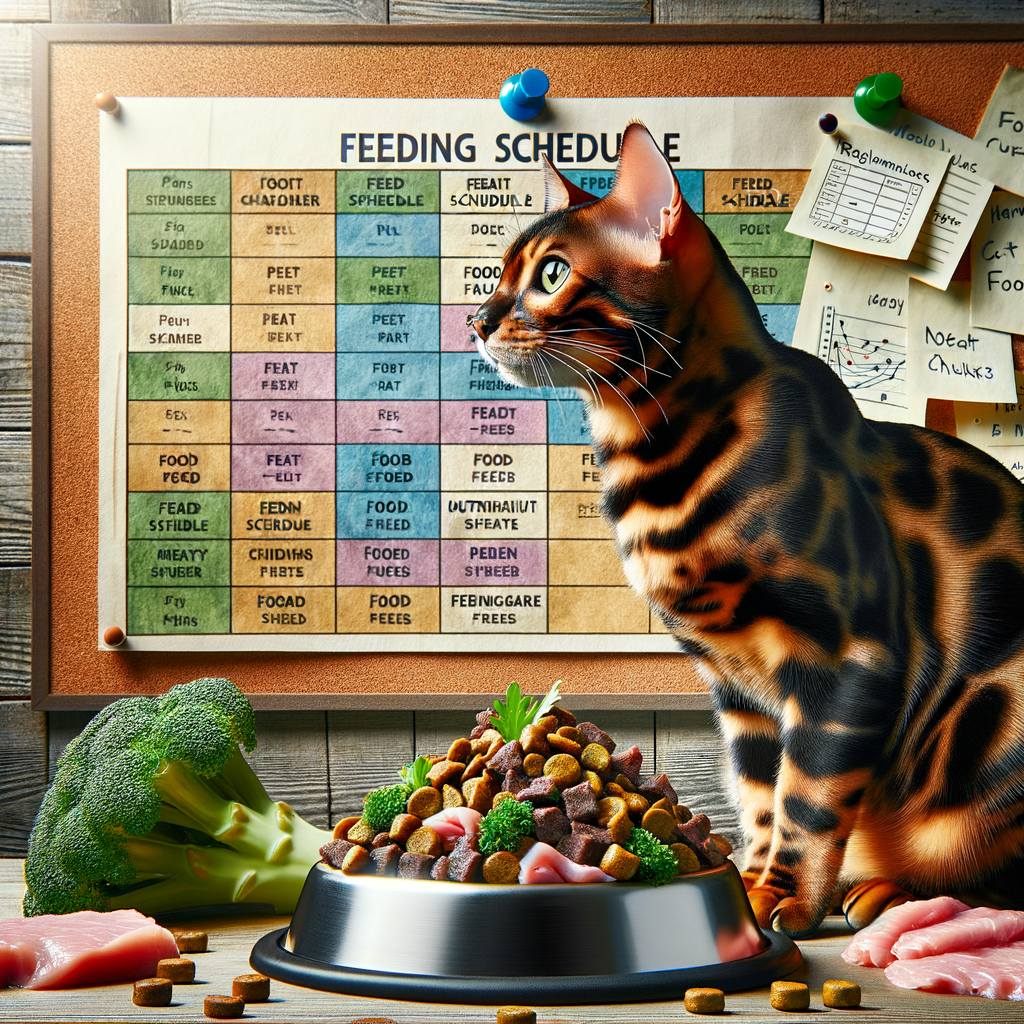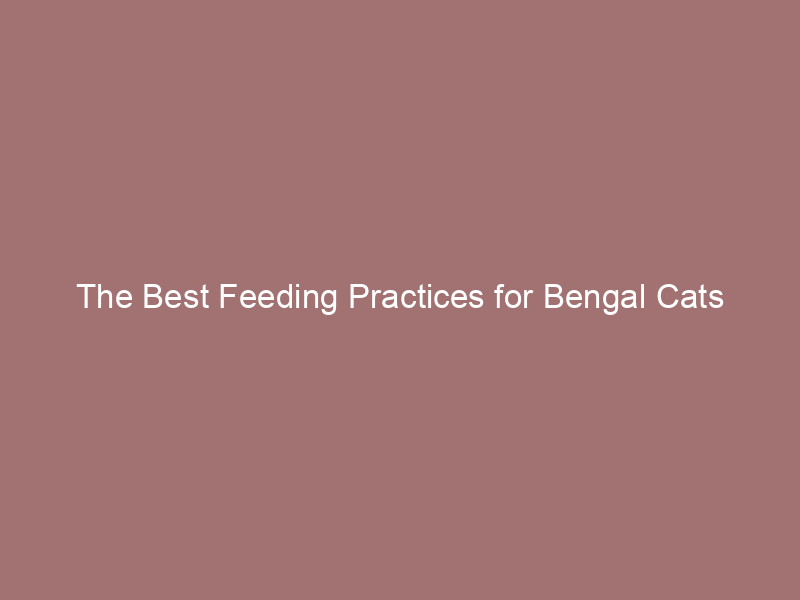
Introduction to Bengal Cat Feeding Guide
Welcome to our Bengal Cat Feeding Guide! In this guide, we will help you understand how to feed your Bengal cat properly.
- Importance of a proper diet for Bengal cats: A proper diet helps your Bengal cat stay healthy, active, and happy. It can prevent many health problems and ensure your cat lives a long life.
- Bengal cat’s unique dietary needs: Bengal cats have special dietary needs. They are very active and need more protein than other cats. Knowing what to feed them is key to their well-being.
In the following sections, we will dive deeper into what makes a good diet for Bengal cats. We will also provide tips on the best foods, feeding schedules, and meal plans to keep your Bengal cat healthy and strong.
Bengal Cat Nutrition
Essential Nutrients for Bengal Cats
- ProteinsProteins are the building blocks of your Bengal cat’s body. They help in muscle growth and repair. A diet rich in proteins keeps your cat strong and active. Look for foods with high-quality animal proteins like chicken, fish, or beef.
- FatsFats provide energy and keep your cat’s coat shiny and healthy. They also help in absorbing vitamins. Ensure your Bengal cat’s diet includes healthy fats from sources like fish oil or chicken fat.
- CarbohydratesCarbohydrates are a source of quick energy. While cats do not need a lot of carbs, a small amount can be beneficial. Look for foods with whole grains or vegetables.
- Vitamins and MineralsVitamins and minerals are vital for your cat’s overall health. They support the immune system, bone health, and more. Ensure your cat’s food contains a balanced mix of vitamins and minerals.
| Nutrient | Importance | Sources |
|---|---|---|
| Proteins | Muscle growth and repair | Chicken, Fish, Beef |
| Fats | Energy and healthy coat | Fish oil, Chicken fat |
| Carbohydrates | Quick energy | Whole grains, Vegetables |
| Vitamins and Minerals | Overall health | Balanced cat food |
By ensuring your Bengal cat gets these essential nutrients, you help them live a healthy and happy life. Always choose high-quality cat food to meet their nutritional needs.
Best Food for Bengal Cats
Commercial Cat Food Recommendations
- Wet food options: Wet food is a great choice for Bengal cats. It helps keep them hydrated and provides essential nutrients. Look for brands like Fancy Feast or Wellness that offer high-quality wet food with real meat as the first ingredient.
- Dry food options: Dry food is convenient and can help keep your cat’s teeth clean. Brands like Blue Buffalo and Hill’s Science Diet offer nutritious dry food options. Make sure to choose a formula that is high in protein and low in fillers.
- Raw food options: Some Bengal cat owners prefer raw food diets. These diets can provide a more natural and nutrient-rich option. Brands like Stella & Chewy’s and Instinct offer raw food options that are safe and balanced. Always consult with your vet before switching to a raw food diet.
| Food Type | Benefits | Brands |
|---|---|---|
| Wet Food | Hydration, essential nutrients | Fancy Feast, Wellness |
| Dry Food | Convenient, dental health | Blue Buffalo, Hill’s Science Diet |
| Raw Food | Natural, nutrient-rich | Stella & Chewy’s, Instinct |
Homemade Food for Bengal Cats
- Benefits and DrawbacksFeeding your Bengal cat homemade food has its pros and cons. Let’s explore them:
Benefits Drawbacks Control over ingredients Time-consuming to prepare Can be more nutritious Requires knowledge of cat nutrition Fresh and free from preservatives May lack essential nutrients if not balanced Homemade food allows you to know exactly what your cat is eating. However, it takes time and effort to ensure the meals are balanced and healthy.
- Recipe ExamplesHere are some simple and nutritious homemade recipes for your Bengal cat:
- Chicken and Rice
- 1 cup cooked chicken (no bones)
- 1/4 cup cooked rice
- 1/4 cup mixed vegetables (carrots, peas)
- 1 teaspoon fish oil
Mix all ingredients together and serve. Ensure the chicken is thoroughly cooked and free of bones.
- Fish and Sweet Potato
- 1 cup cooked fish (salmon or tuna)
- 1/2 cup cooked sweet potato
- 1/4 cup green beans
- 1 teaspoon olive oil
Combine the ingredients and mash them together. Make sure the fish is cooked and deboned.
These recipes are easy to make and provide essential nutrients. Always consult with your vet before making any changes to your cat’s diet.
- Chicken and Rice
Feeding Schedule for Bengal Cats
Feeding Bengal Kittens
- Frequency and portion sizes:
Bengal kittens need to eat more frequently than adult cats. Typically, you should feed them 4-5 times a day. Each meal should be small, about 1/4 to 1/3 cup of kitten food. This helps them get the energy they need to grow. - Transitioning to adult food:
Around the age of 12 months, you can start transitioning your Bengal kitten to adult cat food. Gradually mix the adult food with the kitten food over a week. This helps their stomachs adjust to the new diet without causing digestive issues.
Feeding Adult Bengal Cats
-
Frequency and Portion Sizes
Adult Bengal cats should be fed twice a day. This helps maintain their energy levels and keeps them satisfied. The portion size depends on the cat’s weight and activity level. On average, an adult Bengal cat needs about 25 to 30 calories per pound of body weight each day.
For example, if your Bengal cat weighs 10 pounds, it will need around 250 to 300 calories daily. This can be split into two meals, so each meal would be about 125 to 150 calories.
Cat Weight (lbs) Daily Calories Calories per Meal 8 200-240 100-120 10 250-300 125-150 12 300-360 150-180 -
Adjusting for Activity Level and Health Status
Bengal cats are known for their high energy levels. If your Bengal cat is very active, it might need more calories. Conversely, if your cat is less active or has health issues, it might need fewer calories.
For active Bengal cats, you can increase the portion size slightly. For example, if your 10-pound Bengal cat is very active, you might feed it 300 to 350 calories a day instead of 250 to 300.
If your Bengal cat has health issues like diabetes or kidney disease, consult your vet for a specialized diet plan. They might recommend specific foods or portion sizes to help manage the condition.
Always monitor your cat’s weight and adjust the food portions as needed. Regular vet check-ups can help ensure your Bengal cat stays healthy and happy.
Healthy Diet for Bengal Cats
Preventing Obesity in Bengal Cats
- Recognizing signs of obesity: Look for symptoms like difficulty in moving, visible fat, and a lack of energy. A healthy Bengal cat should have a visible waist and you should be able to feel their ribs without pressing too hard.
- Weight management strategies: To manage your Bengal cat’s weight, ensure they have a balanced diet and regular exercise. Avoid overfeeding and provide portion-controlled meals. Interactive toys and climbing structures can help keep them active.
| Sign of Obesity | Description |
|---|---|
| Difficulty Moving | Struggles to jump or climb |
| Visible Fat | Fat deposits around the abdomen |
| Lack of Energy | Less playful and more lethargic |
Addressing Common Dietary Problems
- Food allergies and intolerancesJust like humans, Bengal cats can have food allergies and intolerances. Common signs include itching, vomiting, and diarrhea. If you notice these symptoms, it might be time to change their diet.
Some common allergens for cats include:
- Chicken
- Beef
- Dairy
- Grains
Switching to a hypoallergenic or limited-ingredient diet can help. Always consult your vet before making any changes.
- Digestive issuesDigestive problems can be a big concern for Bengal cats. Symptoms like bloating, gas, and irregular stools are common. These issues can be caused by:
- Low-quality food
- Sudden diet changes
- Overeating
To help your cat, feed them high-quality, easily digestible food. Also, ensure they have a consistent feeding schedule. If problems persist, consult your vet for advice.
Bengal Cat Meal Plan
Sample Meal Plans
-
For Kittens
Kittens need more nutrients to grow strong and healthy. Here is a sample meal plan for Bengal kittens:
Time Food Amount Morning Wet kitten food 1/4 cup Afternoon Dry kitten food 1/4 cup Evening Wet kitten food 1/4 cup Make sure to provide fresh water at all times. Kittens need frequent meals to support their growth.
-
For Adult Cats
Adult Bengal cats have different nutritional needs. Here is a sample meal plan for adult Bengal cats:
Time Food Amount Morning Wet cat food 1/2 cup Afternoon Dry cat food 1/4 cup Evening Wet cat food 1/2 cup Ensure your adult Bengal cat has access to fresh water. Adjust the food portions based on your cat’s activity level and weight.
Optimal Feeding for Bengal Cats
- Key takeaways:
- Bengal cats need a balanced diet rich in protein.
- Wet food can help keep them hydrated.
- Avoid foods with too many fillers and artificial ingredients.
- Feed them at regular times to maintain a healthy routine.
- Importance of regular vet check-ups:
- Regular vet visits ensure your Bengal cat stays healthy.
- Vets can provide personalized diet advice.
- Early detection of health issues can prevent serious problems.
| Feeding Tip | Details |
|---|---|
| High Protein | Choose foods with chicken, fish, or beef as the main ingredient. |
| Hydration | Incorporate wet food to ensure your cat stays hydrated. |
| Avoid Fillers | Stay away from foods with corn, wheat, or soy fillers. |
| Regular Feeding | Feed your Bengal cat at the same times each day. |






